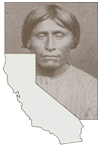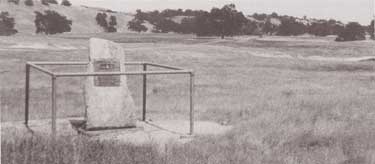![]()

Five Views: An Ethnic Historic Site Survey for California
MENU
Introduction
pre-1769
1769-1848
1849-1879
1880-1904
1905-1933
1934-1964
1965-1980
Historic Sites
Selected References

A History of American Indians in California:
HISTORIC SITES
Nome Lackee Indian Reservation
Tehama County
What remains of the Nome Lackee Indian Military Post is in the rolling foothills of the Coast Range, in the southeast section of Tehama County near Flournoy, California. A survey completed in 1858 indicated that the Nome Lackee Post once encompassed approximately 23,000 acres. A commemorative bronze plaque set in stone reads:
Indian Military Post
1854-1866
Nomi Lakee Indian
Reservation
The foundations of the old military headquarters building and several other buildings also stand on the site. At one time, the Nome Lackee Post was said to have been surrounded by a 10-foot-high, 2-1/2-foot-thick adobe wall used for protection. Within the wall, there were two buildings for government employees, a dining hall and kitchen, a granary, and a warehouse. Outside the wall there were an adobe building for the Indian Agent, a building for an officer and his family, and other buildings including a blacksmith shop, general workshop, doctor's office, grist mill, large barn, and stable. The post had 600 fruit trees and 1,000 acres of grain under cultivation, including 300 acres of rye and barley, with the total acreage estimated to yield 25,000 bushels. There were also five wells on the land, and domestic animals such as cows, fowl, hogs, horses, mules, and oxen.
The U.S. Government established the Nome Lackee Military Post in 1854, two years after it set up the Tejon Military Post in Southern California. Nome Lackee existed for seven years, and was the direct result of the Indian Appropriation Act of March 3, 1852, which authorized the President
. . . to make five military reservations from the public domain in the state of California, or the territories of Utah and New Mexico, bordering on said state, for Indian purposes. Provided that such reservations shall not contain more than twenty-five thousand acres in each . . . that said reservations shall not be made upon any lands inhabited by citizens of California, and the sum of two hundred and fifty thousand dollars is hereby appropriated . . . to defray the expense of subsidizing the Indians in California and removing them to said reservations for protection. . . . (U.S. Congress, Indian Appropriation Act, 31st Congress, 1st Sess., 1852, Vol. 8, Doc. 59:8)
In 1854, Superintendent of Indian Affairs Thomas J. Henley directed the reserve to be located in Northern California, in what is now Tehama County. Henley, with the assistance of H. L. Ford and others, looked for land that would be appropriate for a military post. They eventually found several valleys suited for the purpose, and made contact with the Indians residing in the area, the "Nome Lacka." The Indians agreed to gather together their remaining 300 people and settle on the reservation. From then on, the post was called the Nome Lackee Indian Reservation.
The California public reacted favorably to Indian removal in the 1800s because miners and settlers wanted access to Indian lands. However, the Indians' reaction to removal to the reservations was quite different. One person described how one group of Indians felt upon seeing the reservation land for the first time:
. . . the poor Indians began to show some signs that they had a regret in leaving the place of their birth. The women in the wagons set up that peculiar plaintive cry used by them at their funerals, while the men walked behind the wagons in mournful silence. (San Francisco Evening Bulletin, Sept. 22, 1857, p. 1, col. 2)
Observations of Nome Lackee life in October 1854 indicate that approximately 200 Indians lived on the post with little food or clothing, even though these were to have been provided by the U.S. Government. Conditions changed, however, and by August 1855, it was said that about 1,000 well-fed and clothed Indians were living at Nome Lackee. Records show between 1,500 and 2,000 Indians present by April 1856, with about 1,000 acres of wheat under cultivation. In addition, there were numerous houses and a flour mill.
In 1856, the Nome Cult Farm, an extension to the Nome Lackee Reservation, was established in Mendocino County. It was at this time that a special agent recommended that the Nome Lackee reservation be abandoned, and that the Nome Cult Farm be made into a reservation. However, no one acted on this recommendation. In 1857, General John E. Wool withdrew all of the soldiers stationed at Nome Lackee on the excuse that the land had not been surveyed. In the absence of the military, the Marysville Herald reported that the Indians were regarded as a threat to employees and agents. (Marysville Herald, Jan. 8, 1857, p. 2, col. 1) In spite of the threat, the state continued to send Indians to Nome Lackee, although a group of Yuba Indians were sent to the Nome Cult Farm during this time. In September 1857, reports indicated that the reservation was prosperous and growing. There were between 2,500 and 3,000 Indians living at Nome Lackee, and they harvested between 10,000 and 12,000 bushels of wheat. (San Francisco Evening Bulletin, Sept. 11, 1857. p. 1, col. 2)
In 1858, Henley asked the State Senate and Assembly to send a joint committee to one reservation to report on its management, the condition of the Indians, and the likelihood of the reservation being able to fulfill its humane purposes. He suggested Nome Lackee as a representative reservation. Correspondents of the Alta California accused Henley of fraud in 1858, and he left his position as Superintendent of Indian Affairs in 1859, the year that the U.S. Government began investigations of the entire reservation system.
Washington sent J. Ross Browne and G. Bailey to California to investigate charges of fraud, corruption, and dishonesty. (Goodman, 1966:148) Focusing on Henley and some of the agents he employed, Browne found evidence of fraud, maltreatment, and dishonesty on all reservations. He charged Vincent E. Geiger, then the Indian Agent at Nome Lackee, "with selling equipment that belonged to the Reservation and of being involved with illegal transfers of the Reservation land to private parties." (Goodman, 1966:158) The land transfers occurred after the reservation was improperly surveyed. A large portion of the reservation was omitted from the survey and subsequently acquired by Geiger. Geiger was also charged with indenturing Indians. Although the California Indenture Act of 1855 made this procedure legal, Browne found the practice deplorable, as did much of the public. The Sacramento Union published a list of Indians indentured to Geiger and his associate, F. Titus, under the title, "Indian Indenture: A Nice System of Slavery." Geiger also felt that the lands of Nome Lackee "should be thrown open to the occupancy of our citizens." (Hislop, 1978:49-50)
The Secretary of the Interior called for the abandonment of Nome Lackee in 1859, based on seven facts, including statements that the Indians were peaceful, that Geiger's personal conduct was objectionable, and that mismanagement of the reservation was evident. Although Geiger told people that Nome Lackee was prospering, outside reports indicate that it and the Indians were faring poorly.
On February 27, 1861, the Knights of the Golden Circle, a secret secessionist society from the south that had frequented the reservation with the knowledge of Geiger, attacked Nome Lackee. (Hislop, 1978:57) The reservation was soon in ruins, and most of the Indians were moved to the Nome Cult Farm, which had been made into a reservation called Round Valley. Geiger himself was removed from office. In 1863, he fatally stabbed Captain A. S. Wells, and was reported to have escaped to Victoria, British Columbia.
Under the authority of the Appropriation Act of 1863, the U.S. Government began to sell Nome Lackee land in 1870, but Indians continued to live on the land. There is no evidence, however, to indicate that they benefitted from what remained of the reservation.

Nome Lackee Indian Reservation
NEXT> North Fork School
Last Modified: Wed, Nov 17 2004 10:00:00 pm PDT
http://www.cr.nps.gov/history/online_books/5views/5views1h55.htm
![]()
 Top
Top